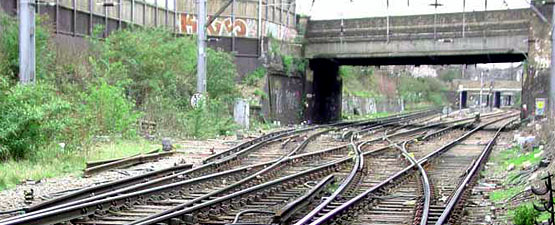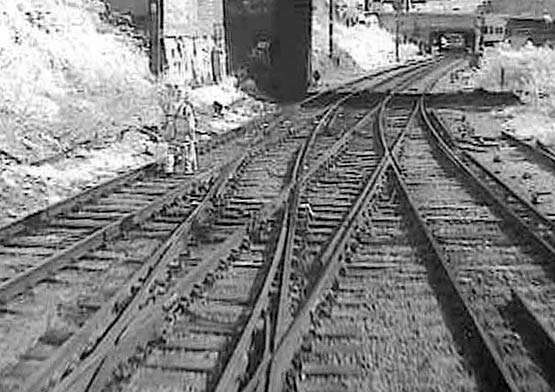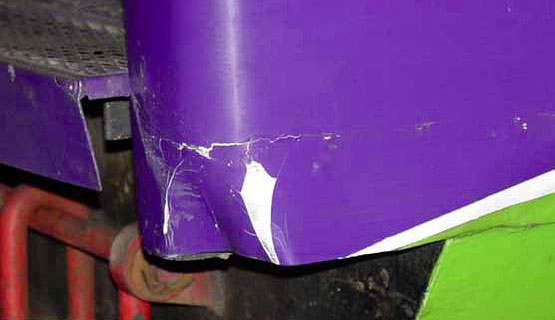|
My memory has officially sunk into the mire of puddledom. Every half hour I ask the wife “what day is it today?” So it came as no surprise when a DeathBy visitor emailed me to say that a recent trackworker inquiry report had fallen under my radar. Actually, I had downloaded it, read it and filed it away on the day of publication. I had simply forgotten to have a good rant about it. The time has now come - well, better late than never.
On 30th March last year, a lookout was struck on the head by a train at Dalston Junction in North London. Remarkably - and possibly thanks to his hardhat! - his injuries were not serious and he has subsequently made a full recovery. But once again, the underlying causes expose deep-seated flaws in the industry’s approach to planning and an unwillingness to tackle the vexed issue of safe cesses. That’s prompted Jungle Ron to wake from his slumber!
 |
| The view looking east from Dalston Junction where the Down No.1 (extreme right) comes together with the Down No.2.
Picture Source: RAIB Rail Accident Report (Crown Copyright)
|
At about 0900 that morning, a group of Carillion and SkyBlue staff met up at Camden Road Station. Their work that day was to assess an infestation of Japanese Knotweed as well as inspecting track and structures on the north side of the railway as far as Dalston Kingsland Station. Their business was part of scoping works for the North London Line Infrastructure Project.
Initially, six people took to the tracks - three involved in the inspection, two lookouts and a COSS. A briefing ensued, identifying a red zone safe system with a position of safety in the Down (north-side) cess. They set off in an easterly direction with their backs to traffic, walking mostly in the cess but sometimes in the four-foot of the Down No.1 line when vegetation, litter and lineside furniture intervened.
At Highbury & Islington Station, the group was joined by three other Carillion staff, two of whom departed again on arrival at Canonbury. The remainder continued towards Dalston. At this point, there are four tracks. One of the lookouts was 150 yards ahead as they approached Dalston Junction where the No.1 and No.2 lines came together to form a two-track railway.
At 1233, train 2N54 - an eastbound Richmond-Stratford service - was routed onto the Down No.2 at Camden Road East Junction - about three miles west of Dalston - to run parallel with the line on which the group was working. As he approached Dalston Junction, the driver - a trainee under instruction - slowed his train from 40mph to observe the 15mph speed restriction. He sounded the horn when the workgroup came into view on the other side of the railway - an act that was acknowledged by at least three of its members.
When he then observed the lookout beyond the group, another warning was given. The lookout - walking in the four-foot with his back to the train - acknowledged. Three seconds before crossing the junction, the driver blasted the horn again but the lookout didn’t move clear. As a result, the left-hand front corner of the unit struck him on the back of the head. His colleagues ran over to provide first aid.
 |
| The final frame of the train's CCTV system, showing the lookout with his back to traffic in the four-foot of the Down No.1.
Picture Source: RAIB Rail Accident Report (Crown Copyright)
|
For obvious reasons, the assessment of Japanese Knotweed infestation was not something that could be done in darkness. In any case, the engineer responsible for dealing with vegetation on that particular work package had to be present on the inspection and he was only available during daylight on weekdays. The project delivery manager told the engineer that green zone working would not be possible due to the volume of traffic using the route. However this information was based on the line blockage opportunities for the No.2 lines - used by high-density passenger services - rather than the No.1s on which the group would be working. These are freight only with sometimes one hour between trains. Nevertheless, a request was submitted for a red zone plan.
(The RAIB inquiry states that it would have been an “appropriate method of protection” to divide the inspection into shorter pieces of work, each lasting less than 60 minutes, and then applying a series of T12 blockages. This though is a manipulation of the T12 rules and contrary to their intent.)
At the time of the accident, the Rimini planner had been in the job for a month and a significant workload was bearing on his shoulders. He had passed a core planner course and recently qualified as a COSS but had not worked in that role before joining the project. There had been no opportunity for a site visit or to otherwise familiarise himself with the area for which he was making plans - he had to rely on his interpretation of the information contained in relevant documentation.
Although much of its content was irrelevant, he prepared a pack consisting of nine sheets of paper. This was passed to the Carillion planning manager for checking. He was also unfamiliar with the North London Line but reviewed and signed it off anyway. The pack was then sent to the engineer and HSE Adviser for the project but, due to an oversight, it was not forwarded to the COSS. He eventually got it just five minutes before his group arrived to start work. The proposed method of work was not challenged by him, possibly influenced by his status as a contractor and the presence of both a health and safety adviser and engineering staff who had been involved in planning the work.
|
| He eventually got it just five minutes before his group arrived to start work. |
|
The protection staff being used on the project were supplied by SkyBlue and came from various parts of the country, travelling to London on the day of their shift. In March 2009, the project director asked that this practice cease but the company did not immediately have a local workforce of sufficient numbers. Consequently this requirement was phased in as recruitment progressed, a process that hadn’t been completed by the date of the accident. The COSS and lookouts involved on 30th March were booked by SkyBlue’s Birmingham office and left there at 0600 that morning. However, given their work patterns over the previous few days, there is no evidence to suggest that fatigue played any part in the subsequent events.
Neither the COSS nor the injured lookout were familiar with the area, never having visited the site before. So the casualty was unaware that the four-track section ended at Dalston Junction and didn’t realise this from what he saw of the track layout. He had evidently become accustomed to acknowledging warnings from the frequent passenger trains that rattled by on the No.2 lines and he probably assumed that 2N54 would also pass him harmlessly.
 |
| The damage caused to the unit.
Picture Source: RAIB Rail Accident Report (Crown Copyright)
|
With mobile workgroups, custom and practice is for the COSS to give lookouts an indication of where they should go but for the lookouts to position themselves in order to give the best possible warning of approaching trains. Here, witness evidence indicates that the COSS had briefed the lookout that his position of safety was in the Down cess. However its condition was so poor that the path along it was uneven, obstructed and, in some places, non-existent. So for much of the time the group walked on the sleeper ends or in the four-foot of the Down No.1. The accident occurred towards the end of the inspection when this practice had become habitual. The inquiry found that “the lookout might not have chosen to walk in the four-foot” if the cess had been maintained in a usable condition. Its state was therefore a contributory factor.
Network Rail’s standard relating to the management of lineside vegetation, NR/L2/TRK/5201, requires that the cess is maintained clear of trees, shrubs and brambles and 95% clear of other vegetation by annual clearance. The North London Line runs through an urban area and has become something of a rubbish dump. The contract for the project includes cleaning up the lineside, upgrading of access arrangements and provision of safe walking routes adjacent to bi-directionally signalled lines, including the area where the accident occurred. Thus, the stable door will soon be securely bolted.
 |
| The cess conditions of the approach to Dalston Junction.
Picture Source: RAIB Rail Accident Report (Crown Copyright)
|
RAIB makes only three recommendations as others would simply repeat those issued following similar previous events. It is worth making the point that Network Rail has not yet responded to three such recommendations. To be fair, although one of these arises from an accident more than two years ago, the report was only published in July of last year - proving once again that RAIB’s excessive inquiry timescales are having a negative impact on safety improvement.
It says much about the industry’s attitude to practical safety management that yet another accident has been found to have planning deficiencies at its heart. The tick-box, drown-them-in-paperwork culture has become a malignant tumour, often leaving those at trackside without the critical knowledge needed to stay safe. Perversely, the advent of Rimini planners has compounded the problem - devolving responsibility for safe systems from previously high-skilled COSSs onto those with sometimes questionable experience. That’s an untenable state of affairs. But what’s worse is the inability of those at the top to get a grip on this problem and drive forward a real solution. That’s a failing for which trackworkers pay far too often.
|